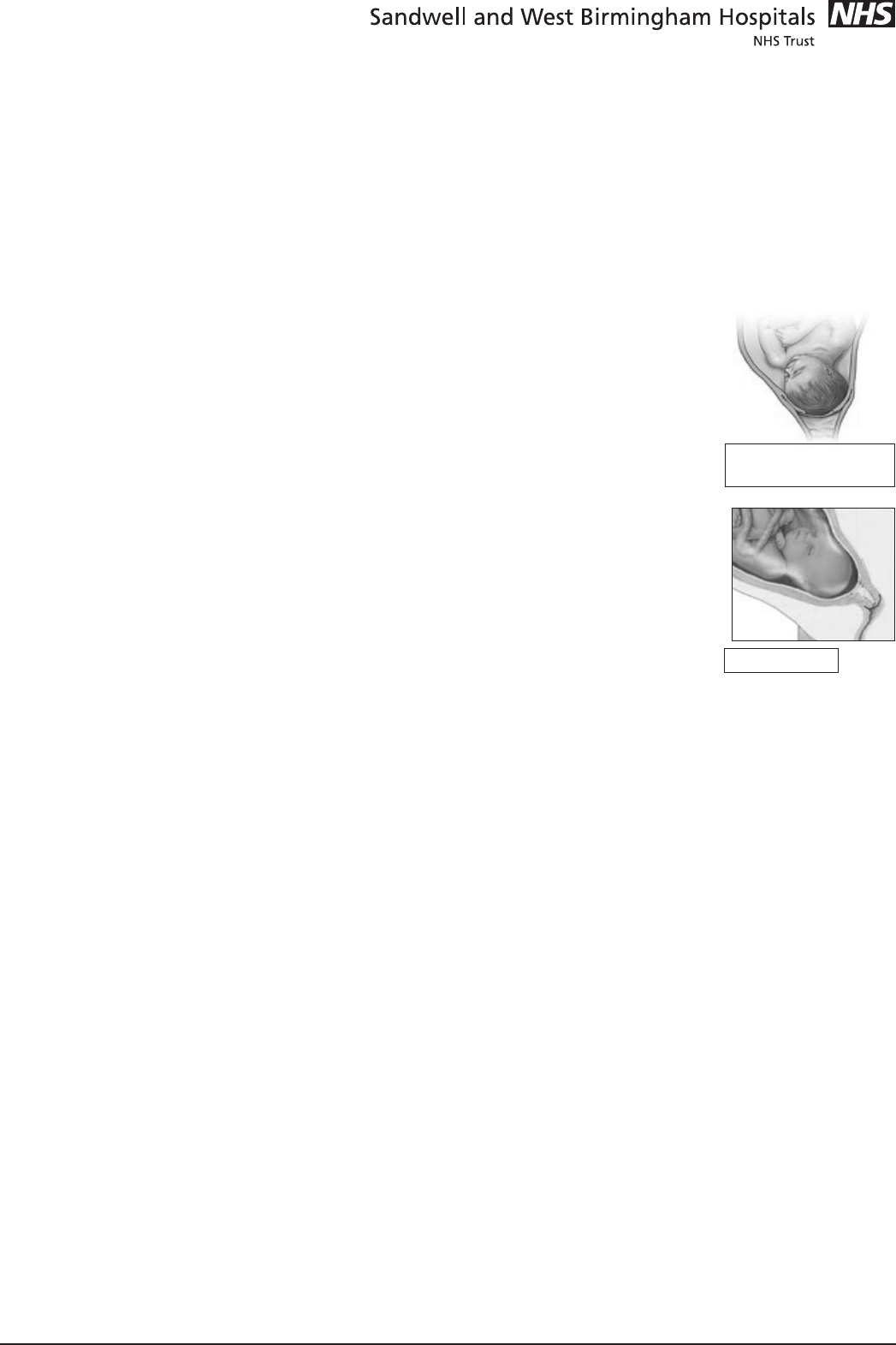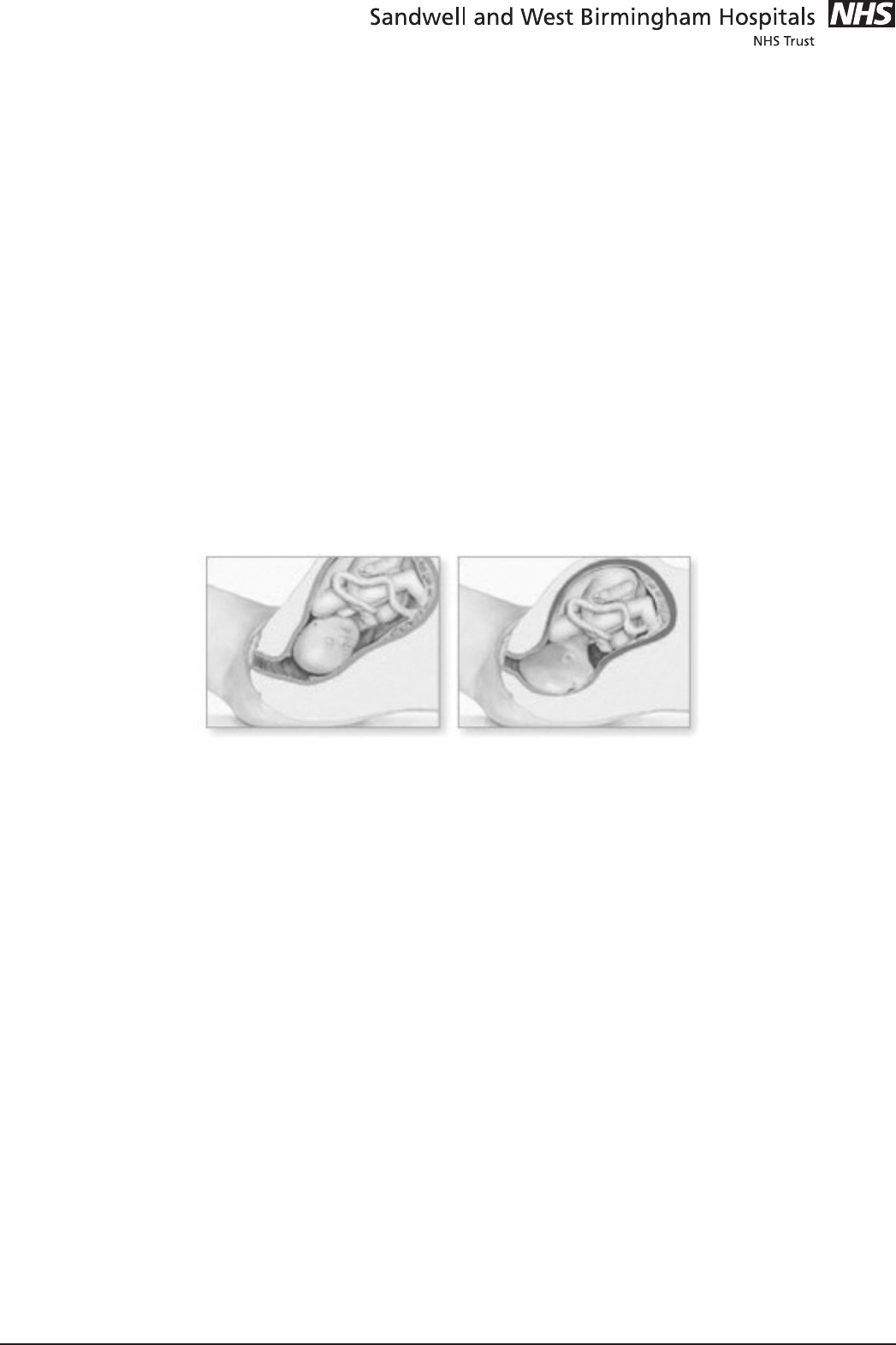
Information and advice for mothers-to-be
Maternity
The latent phase of labour: how to recognise
what is happening and how to cope
Page 1
What is the latent phase of labour?
When you reach the end of your pregnancy it is normal to feel apprehensive
or even excited about the start of labour. Before labour starts, the neck of
the womb (cervix) is long, firm and closed but this changes in the last few
weeks of pregnancy.
The latent phase of labour is the build up period before the start of labour.
During the latent phase the neck of your womb (cervix) thins and opens
up (dilates) to 4 cm.
As the cervix stretches and fits around the baby’s head you will experience
some sharp pains - this is normal. Some of these pains can be quite sharp
or even feel strong however they do not mean that labour is about to start
– they are known as Braxton Hicks contractions. You might find that you
have a ‘show’ (the mucous plug), which is likely to happen anytime from
37-42 weeks during your pregnancy. The show can look like the
mucous that is on a tissue when you blow your nose, sometimes it has streaks of blood in it.
This is all part of the normal build up to labour.
Once the latent phase of labour has done its work you will go into the first active stage of
labour; this is when labour has become ‘established’ and the contractions become regular
and stronger.
How do I recognise the latent phase of labour?
Some women can feel backache or cramps during this time and even have bouts of
contractions lasting a few hours which then stop and start up again the next day. This is
normal and can last on and off for days and might be very tiring for you.
How can I manage the latent phase of labour?
The best place for you to be during the latent phase of labour is at home where you can feel
more comfortable and relaxed.
Tips to help you cope
• Keep active – Moving around will help your labour to progress normally, so do some light
housework or take the children or dog for a walk.
• Eat and drink as normal – It is important to keep your energy up so eat some small snacks
that are high in calories and drink plenty of water.
• Make sure that you are going to the toilet normally – If you have emptied your bowels
frequently it can help labour to start.
Cervix stretching
around baby’s head
Mucous plug

Information and advice for mothers-to-be
Maternity
The latent phase of labour: how to recognise
what is happening and how to cope
• Rock your pelvis and sway your hips – This can help you manage the pain. If you have
access to a birthing ball, use it regularly as this too can alleviate any discomfort.
• Have lots of warm baths – Warm water is very soothing when you have this sort of
discomfort.
• Put your TENS unit on – If you have decided to use one of these you will have had
instructions on how to apply it.
• Use massage and aromatherapy oils – These can help you to relax and sleep between the
tightenings.
• Use relaxation, breathing or hypnobirthing techniques – If you have been practising these
techniques, they will help to relax and manage the discomfort at this time.
• Take 2 Paracetamol (500mg) tablets and repeat 4 hourly – do not exceed 8 tablets in 24
hours.
• Make love – kissing, cuddling and having an orgasm all cause your body to produce the
labour hormone oxytocin. Oxytocin is the hormone that makes the muscles in the womb
contract strongly.
You may also want to call your birthing partner for added support during this time. S/he
should give you support and reassurance to help reduce your anxiety. Your birthing partner
can also make other family members aware that you are in the latent phase of labour and
encourage them to give you support rather than raise concerns.
What is the difference between labour contractions and Braxton Hicks
contractions?
‘Braxton Hicks’ contractions occur throughout pregnancy. They are tightening of the muscles
of the uterus and last for about 30 seconds. They are usually painless but might feel tight
and uncomfortable. They do not harm the baby. During the latent phase of labour, Braxton
Hicks contractions may become more noticeable and more frequent, lasting between 30 and
45 seconds.
You ARE NOT having labour contractions when:
• the contractions are irregular and short lasting
• the contractions do not get closer together
• walking or changing your position does not affect the contraction
• they reduce in strength
• resting may stop them
• you feel them in the front and groin area
Page 2

Information and advice for mothers-to-be
Maternity
The latent phase of labour: how to recognise
what is happening and how to cope
You ARE having labour contractions when:
• the tightenings become more frequent and regular
• they are at least every 3-4 minutes and last for more than 1 minute
• they feel stronger and painful
When you are having labour contractions you might find that you need to use the toilet a lot
– this is because your body is getting ready for labour.
When should I come into hospital/the birth centre?
The best place for you to be during the latent phase of labour is at home. If you are more
relaxed during the latent phase of labour at home, you will move into the 1
st
stage of labour
more quickly. You should call us when you feel that your labour is progressing into the 1
st
stage (you are having labour contractions as described above) to let us know that you are
coming into hospital/the birth centre.
If you have tried all of the tips and ways to cope at home and feel anxious or you are in more
pain than you expected then contact us for advice.
If you are invited to go into the hospital then take an overnight bag with you. When
you arrive you will have a thorough examination to determine whether your labour has
established or not. If your labour has not yet established you may be asked to return home,
because this is the best place for you to be during the latent phase.
You should come into Triage in the Maternity Unit at City Hospital if:
• Your waters break and are stained (green or black colour)
• You are bleeding fresh blood
• Your baby has not moved the way it normally does during the last 24 hours
Uterus between
contractions
Uterus during
contractions
Page 3

If you would like to suggest any amendments or improvements to this leaflet please contact the
communications department on 0121 507 5495 or email: swb-tr[email protected]
ML4672
Issue Date: October 2014
Review Date: October 2016
A Teaching Trust of The University of Birmingham
Incorporating City, Sandwell and Rowley Regis Hospitals
© Sandwell and West Birmingham Hospitals NHS Trust
Information and advice for mothers-to-be
Maternity
The latent phase of labour: how to recognise
what is happening and how to cope
Page 4
Contact details
If you are high risk
Triage: 0121 507 4181
If you are low risk
Serenity Birth Centre: 0121 507 5655
Further information
For more information about labour, birth and how to cope please see the leaflet ‘Labour:
what happens and how it can be managed’.
You can also find more information about our Maternity services and other leaflets about
pregnancy and birth on the maternity pages of our website:
Sandwell and West Birmingham Hospitals NHS Trust
www.swbh.nhs.uk
